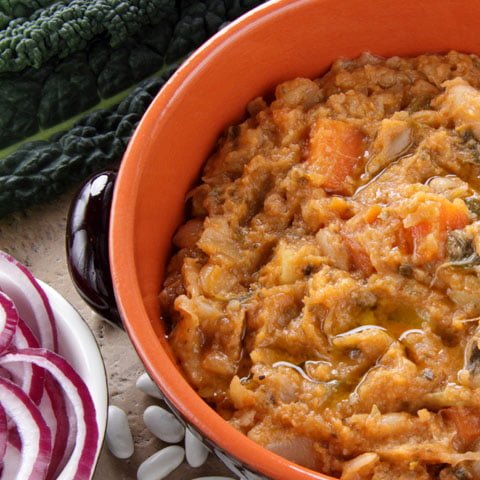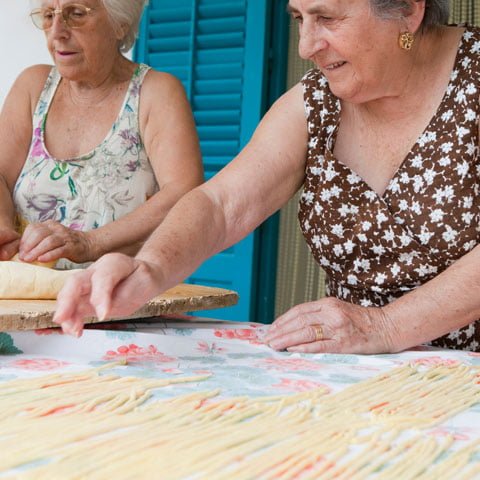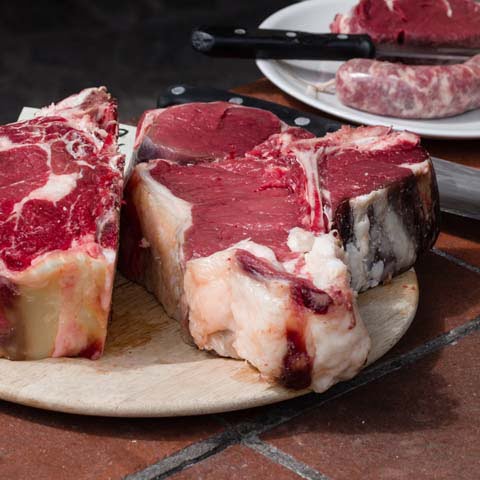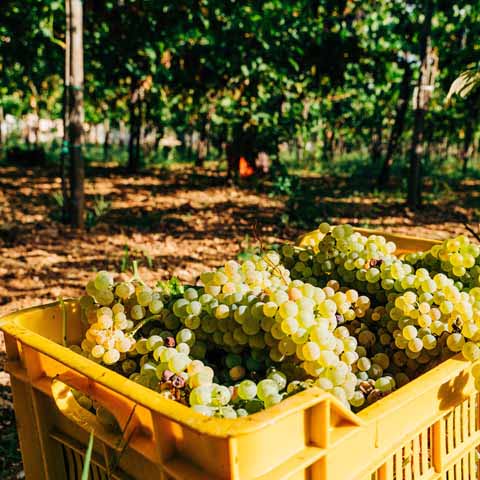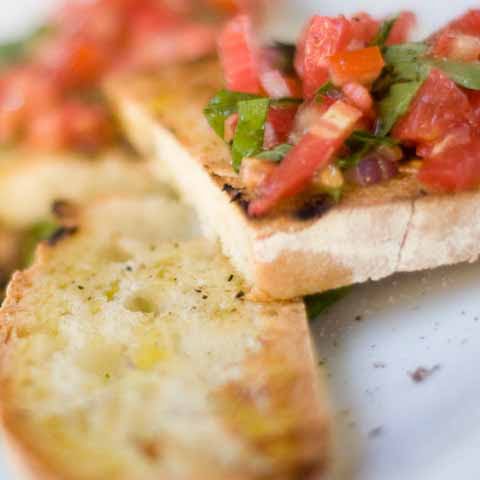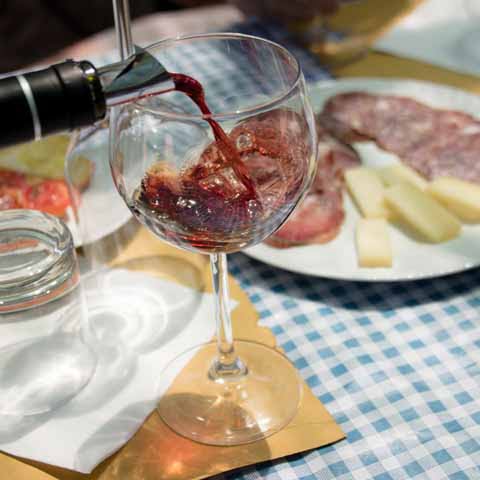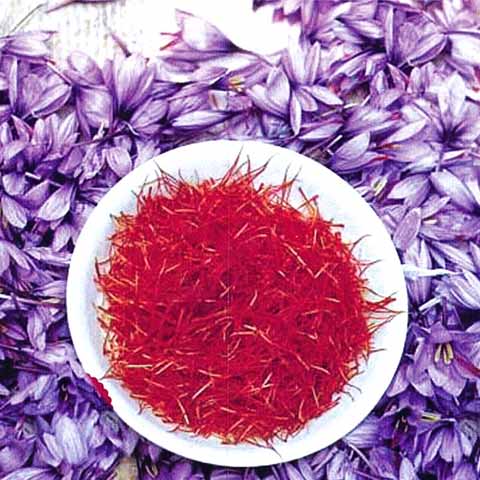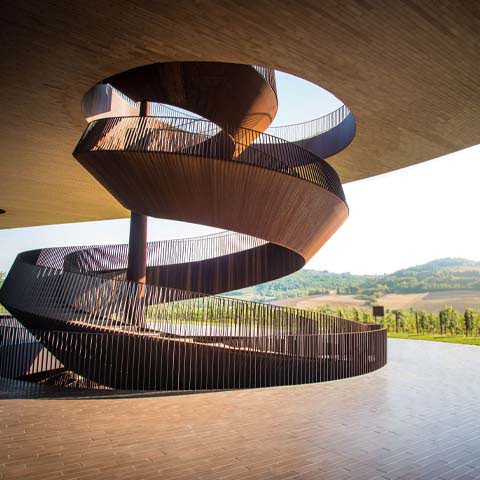Keeping with the traditions of Tuscan cuisine, the food found in San Gimignano is fresh and flavorful. The ingredients utilized are locally grown and raised on the vast hillsides the area is known for. Menus throughout the city reflect availability depending upon the season and local production. The resulting dishes are simple, yet hearty and quite common in the Tuscany region. By utilizing their readily available resources, recipes are created inexpensively.
From fresh produce and herbs to meat and breads, the abundance of local ingredients grown in and around the town provides for authentic Italian recipes. While many food items are common throughout the country such as pasta, bread, and olive oil – each region, province, and city adds its own touch to make it unique for their local cuisine, and San Gimignano is no different.
While known for its skyline of medieval towers, the city is also renowned for an important ingredient to local cuisine – Crocus savitas, also known as saffron. Some of the most superior saffron in all of Italy is cultivated in the surrounding countryside. The locally grown variety has consequently received the IGP designation for its consistent high quality. While it is quite pricey, its light flavor and attractive aroma can be found in many local recipes – giving each dish a golden tint.
Located in the province of Siena in Central Italy, San Gimignano sits amidst the scenic Tuscan wine country. Beginning in medieval times, the city gained a reputation for producing some of the best wine in Italy – most notably those featuring the Vernaccia grape found in the area’s vineyards. It was said to be popular among historical figures including Boccaccio and Dante – even finding its way into the latter’s Divine Comedy. San Gimignano is a must for any wine lover’s itinerary as it is home to the first national vino to be recognized with the DOC, or Denomination of Controlled Origin, label in 1966. Roughly 30 years later, it received the DOCG, or Denomination of Guaranteed Controlled Origin, status.
APPETIZER
Local ingredients typically make their first appearance right from the start of the meal in San Gimignano. A common appetizer consists of a variety of locally produced cheeses and cured meats. Typically, the cheese served is produced from goat or cow milk and the flavor varies depending upon its ripeness, the season in which it was produced, and any incorporated local herbs for added flavor and aroma. The most common varieties found in the area are pecorino cheeses – fresh and seasoned, including: Pecorino Fresco, Pecorino Semistagionato, and Pecorino Stagionato.
Among the cured meats traditionally served are prosciutto, salame, finocchiona, sopressata, and buristo.
Bread is often served alongside the cured meats and cheeses. It can be plain or dressed up as a crostino (small slices of grilled or toasted bread topped with a spread – chicken liver is common in Tuscany) or bruschetta (grilled bread rubbed with garlic and topped with fresh tomatoes, extra virgin olive oil, and basil or other ingredients).
A common vegetable-based appetizer is eggplant pie, which consists of grilled eggplant slices baked with alternating layers of mozzarella and tomato sauce.
FIRST COURSE
Following a light appetizer, the first course frequently presents a pasta dish or soup.
One popular choice in San Gimignano is the traditional homemade pici pasta – thick spaghetti-like pasta originating from nearby Siena that may be served with a rich, red sauce, garlic and olive oil, a meat sauce, or mixed with fresh vegetables. One meat sauce often served with pici is wild boar ragù.
As with the rest of Tuscany, the residents of this historic, medieval town truly enjoy their soups. Ribollita is a regional favorite that translates to mean “reboiled” and it is just that. The leftovers of what was originally a vegetable soup are reheated and combined with extra, semi-stale bread on hand to create a whole new meal. Other common soup choices include tomato soup and spelt soup. The soups prepared in San Gimignano are healthy and hearty while being economical and using ingredients available in their own backyard.
Crespelle with asparagus and robiola cheese is another popular appetizer. The dish consists of thin crepes stuffed with asparagus and robiola then baked and topped with breadcrumbs. Based on the season, crespelle may be stuffed with other available, locally-grown ingredients.
A classic risotto dish that incorporates several of San Gimignano’s local ingredients is risotto with mascarpone cheese, artichokes, and saffron.
SECOND COURSE
The star of the second course in Italy is meat, meat, and more meat. In San Gimignano there are various meats available from pork and chicken to rabbit and wild boar.
The latter in particular is a local favorite as there is a large supply of cinghiale, or wild boar available. It can be found in stews (often cooked in local Vernaccia wine or with saffron), sausages, salame, and incorporated into pasta dishes. Sopressata consists of the portions of the boar that are lower in value and tough, yet flavorful. It is boiled, wrapped in jute cloth, and seasoned with nutmeg, lemon zest, salt and pepper. Another variety of this meat is cinta senese – a locally raised, white-belted pig that is native to the province of Siena. Raised on a natural diet with an abundance of acorns, the resulting meat is tasty and ideal for making prosciutto, pancetta, guanciale, and other cured or smoked meats.
Other traditional dishes served during the second course include scottiglia – a slow cooked mixture of any choice meat with tomatoes and herbs served over toasted garlic-rubbed bread, rabbit cooked in local Vernaccia wine, rabbit and leek salad, cinta senese pork served with cabbage, and stuffed veal rolls with artichokes.
SIDES & CONDIMENTS
Vegetables grown in and around San Gimignano are frequent additions to any meal. Depending upon the time of year, potatoes, spinach, peas, and artichokes are among the vegetables that may make it on the plate. From grilled to roasted and fried to sauteed, they are sure to be fresh.
As found throughout Tuscany, beans are a popular side dish in San Gimignano. Often referred to as mangiafagioli, or bean eaters, Tuscans enjoy their protein-packed legumes in various ways – alone or incorporated into a traditional recipe.
Among the typical condiments found on local tables is honey. While there are 15 different types found throughout the region, San Gimignano is known for producing two varieties – Millefiori and Acacia. To enjoy the sweet syrup like a local, it can be served with cheese, bread, and atop cakes.
STREET FOOD
The convenience of street food while exploring the city enables flexibility while not taking away from enjoying the local cuisine. Whether admiring the sites around the city or people watching from a park bench, there are light snacks as well as whole meals available on-the-go. Typically found at food carts or walk-up windows at a small bakery or cafe, there is something for everyone.
An easy, yet satisfying choice is a selection of locally produced sliced bread, cheese and cured meats such as salame. Another favorite finger food to eat along the way is cecina – a light chickpea flatbread often topped with a sprinkling of olive oil and pepper.
DESSERT
Dessert in San Gimignano is the finishing touch to a meal that cannot be passed up. Popular dessert choices to try in San Gimignano include panaforte – a dense traditional Tuscan cake that contains fruits, nuts, spices and ricciarelli – a unique cookie containing candied citron and orange zest. Recipes for both desserts can vary from bakery to bakery, with secret twists and additions to make it their own. It can be an adventure in itself to try the sweet variations found throughout the town and surrounding area.
Other favorites include zuccotto allo zafferano, a sponge cake flavored with saffron, and torta di riso, a simple cake made with rice, sugar, milk, amaretti, almonds, lemon zest, and candied fruit.
WINE IN SAN GIMIGNANO
A meal in Italy, more specifically in the middle of the Tuscan wine country, is not complete without a glass of renowned, locally-produced wine. Historically, San Gimignano has been known for its own white Vernaccia vino – named for the grapes it is made from. The surrounding hilly landscape provides ideal conditions for the endless vineyards that cross them. Visitors can travel the road of the Vernaccia di San Gimignano and experience the scenery and vineyards along the way.
Vernaccia is best when chilled and is a perfect match with vegetables, fish and white meat recipes; whereas Vernaccia Riserva (aged for a minimum of 12 months) is typically served closer to a room temperature and goes well with seafood.
Other high quality wines can also be found in San Gimignano including: Chianti Colli Senesi and San Gimignano Vin Santo.
Tucked away in the picturesque Tuscan countryside, the medieval town of San Gimignano is the perfect place to experience fresh and local flavors. With staple ingredients such as saffron and wild boar combined with the fantastic local Vernaccia wine, unforgettable meals in San Gimignano are guaranteed.
Travel Guides
The Tuscany Region of Italy
The Cities of Tuscany, Italy
